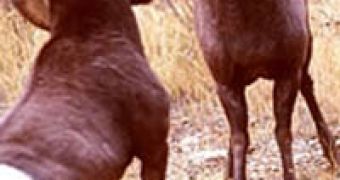1. The bighorn sheep originates in Siberia. It reached North America 100,000 years ago. Sheep's genus, Ovis, has common origin with the goat's genus, Capra. 20,000 years ago, in the southern Rocky Mountains lived Ovis catclawensis, a ship 12-20 % longer than the bighorn (Ovis canadensis) and 50-70 % heavier. This large sheep resembling the snow sheep (Ovis nivicola) of Siberia had crossed the Behring land bridge 100,000 years ago. Dall's sheep crossed the Behring in a more recent interglacial period.
2. The bighorns live in separate herds, females with lambs and males (2 to 12). They make altitudinal migrations during the winter, when they descend from the summer locations at altitudes of 1,800-2,600 m (6,000-8,660 ft) in the Rocky Mountains or 3,800-4,500 ft (12,660-15,000 ft) in Sierra Nevada Mountains to 800-1,600 m (2,660-5,330 ft). During the winter, they avoid areas with snow under 1.8 m (6 ft), that's why they miss on the western coast. In the desert, the bighorns stay at 1-3 km (0.6-1.6 mi) around a water source.
3. Bighorns are 1.2-1.8 m (4-6 ft) long (the tail is 7-15 cm or 0.25-0.5 ft long), height at the shoulder is 0.65-1.25 m (2.2-4.2 ft). The ram weighs 60-140 kg (130-300 pounds), the ewe 30-90 kg (66-200 pounds). On flat terrain, bighorns can run with 50 km (31 mi) per hour, with jumps of 4 m (13 ft) long while the normal step is of 50 cm (1.6 ft).
4. Moulting takes place in June-July. 90 % of the cellulose is digested, one of the largest levels amongst all ruminants.
5. Female's heat lasts just 48 hours and if she is not fertilized, she enters in heat again several days later. The male is polygamous and the female polyandric (she mates with several males). Sexual maturity is achieved at the age of 18-24 months by the female, and 18-36 months by the male, but he has little chance of mating before 7 years old, as he does not have impressive horns yet. By the age of 13-15 years, males are sterile.
Mating takes place in November-December in the Rocky Mountains and August-September in the desert. Females can take the initiative, and they prefer fit males instead of those exhausted by multiple sexual contacts. Only dominant males mate, and the mating is quick.
Inside the male herds, hierarchy is established through horn fights, and the females prefer males with the largest horns. Charges take place from 5-15 m (16-50 ft) and are made with a speed of 35 km (22 mi) per hour. The noise can be heard 1.5 km (0.9 mi) away. Only males of similar sizes fight, and they do not harm each other; as the weaker abandons the fight.
Gestation lasts 170-180 days, and births occur in April-June, in the south all year round, but concentrated in January-April. The females have one, rarely two, lamb(s), weighing 3-5 kg (6.6-11 pounds). The milk contains 76 % water, 10 % fat (thrice than the cow's milk), 8 % proteins, 5 % lactose (sugar) and 1 % minerals.
At two weeks old, the lamb starts consuming plants. The female defends the young as long as she does not put herself in danger. The lamb is weaned at the age of 4-5 months. In the first fall, the young has 30 kg (66 pounds).
6. At 6 months old, the horns are 6-7 cm (2.4-2.8 in) long. Horns' growth stops during the winter and in case of drought or disease. At 7-8 years old, the male's horns can be 1.1 m (3.6 ft) long and be 46 cm (1.5 ft) wide. The record was of 83 cm (2.7 ft) width. The horns represents 8-12 % of the animal's weight (6-15 kg or 14-33 pounds), the absolute record amongst ruminants. The tip of the horns is abated on trees or stones, so that it does not limit the male's visual field.
7. The hearing is kin; they detect the click of a photo camera from 50 m (166 ft). The sight is the most developed sense; they can see a predator located 1 km (0.6 mi) away.
8. There are 3 subspecies of bighorn. 20,000 Rocky Mountain Bighorns (Ovis canadensis canadensis) are found from Alberta (Canada) to Colorado (US). 3,500 Sierra Nevada Bighorns (O.c.sierrae) live from British Columbia to California. 14,000 desert sheep (O.c.nelsoni) are found in California, Nevada, Arizona, New Mexico and Mexico (Baja California, Chihuahua, Sonora). Rocky Mountains bighorn is the largest type.
9. The main predators are the pumas (for adults) and eagles (for lambs). Pumas kill many bighorns especially during the winter, when the sheep descend from the mountain heights. Bighorns can catch diseases from the domestic sheep. In the desert, bighorns face competition with the introduced burros (bewildered donkeys) and Barbary sheep (Ammotragus lervia), a species from Sahara which flourishes in the deserts of North America.

 14 DAY TRIAL //
14 DAY TRIAL //